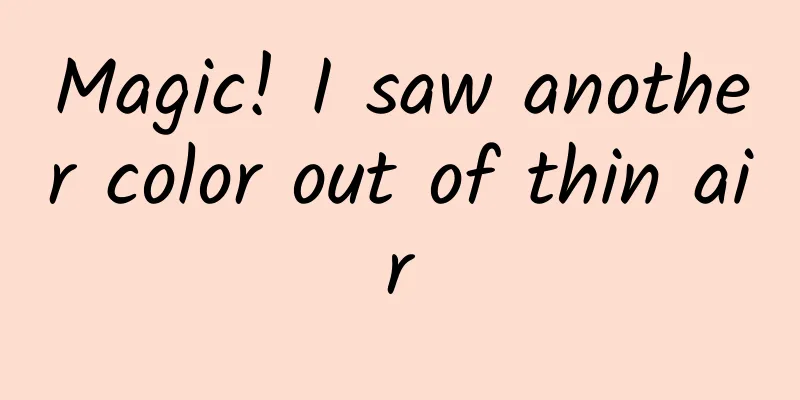Magic! I saw another color out of thin air

|
Complementary colors are also called complementary colors or residual colors. When two colors are mixed to form a neutral color, the two colors are called complementary colors. Neutral colors are mostly black and gray. A specific color has only one "fixed CP". Yellow and blue, cyan and red are all complementary colors. Is there really only one complementary color? There is a method that can help you quickly verify it. Try to stare at a piece of red cloth for a long time, and when visual fatigue forms, quickly move your eyes to the white background. You will feel a green image appearing on the white wall. This visual afterimage shows that visual balance requires complementary colors as an adjustment. Green, as the only complementary color of red, is naturally the best choice. Image source: Internet When you don't know the complementary color of a color, this method can help you get it quickly. Isn't it amazing? How do eyes clearly capture colors? How does the phenomenon of complementary colors occur? What special color vision phenomena will be caused by complementary colors? There is a lot of science behind these magical phenomena... Light and Color Our eyes are special organs with an optical system. They can sense light because the inner layer of the retina contains ganglion cells connected to the optic nerve, which are responsible for transmitting light information to the brain. The pupil adapts to light changes by contracting and dilating. When light stimulates the eyes, the physiological structure of the eyes will affect people's perception of color, that is, the color we see is not necessarily the real color of light. When we suddenly go from a dimly lit room to a sunny outdoor, we feel it is very dazzling and need a few seconds to adapt to observe objects normally. If we go from a bright place to a dark place, we will suddenly not be able to see clearly. After a sufficient period of adaptation, our eyes can see things clearly. This shows that the eyes have the function of automatically adjusting to light, and this adjustment and adaptation ability comes from the two color-sensitive cells on the retina, the cone cells and rod cells. Cone cells occupy the "center" of the retina and are the most sensitive part of vision. In bright light conditions, cone cells can distinguish even the slightest color changes. Their visual advantage of being able to adapt to bright conditions is called "bright vision". Rod cells are just the opposite. They only work in dim light conditions and can only distinguish light and dark, not color. Because they can adapt to vision in dim light conditions, they are called "scotopic vision". Image source: pexels There are three types of color-sensitive cone cells on our retina, which can produce various color sensations in the visual center of the cerebral cortex. It is this visual structure that causes some special color vision phenomena, which is what we call "visual complementary colors." Special color vision phenomenon Human vision requires a physiological balance for colors. No matter what color is reflected in our eyes, our vision will require its relative complementary color. When we suddenly go from a daylight environment to an incandescent light environment, we will feel that objects in the new environment are yellow. Of course, this feeling is short-lived, and the eyes will soon return to the feeling in the daylight. The stimulation of different colors to the eyes will cause changes in vision. This change is the adaptation of vision to different colors of light. When the eyes adapt to a certain color of light, the eyes' perception of the latter color is almost the complementary color of the original color. Image source: pexels Place a colored shape on a gray or white background. If someone takes the shape away after looking at it for a long time, you will find that a shape with the complementary color of the original color will appear on the background. If you look at a white figure with a gray background, the complementary color figure that appears is the dark afterimage of the figure. When the figure changes to black, a bright afterimage will appear in your eyes. This is also the magical visual experience brought by the principle of complementary colors! When do we encounter visual complementary colors in daily life? In medical TV dramas, we always see doctors wearing green surgical gowns during surgery, not the common white coats. The reason for this is that during the operation, the doctor's field of vision is always filled with bright red bloodstains, and long-term high tension causes visual fatigue. When the doctor shifts his gaze, if the people around him are all wearing white coats, under the principle of visual complementary colors, spots of "green bloodstains" will appear in the doctor's eyes. This illusion is very dangerous and will affect the doctor's judgment. The way hospitals eliminate the green illusion is mainly to use green surgical gowns, which can not only reduce the fatigue of doctors' optic nerves, but also provide patients with a safer surgical environment. Image source: pexels The famous Impressionist painter Van Gogh was particularly good at using the principle of visual complementary colors to create works, such as the following painting "Cafe Under the Stars". Van Gogh used orange and blue to enhance each other to strengthen the visual impact of the picture. The windows are in saturated orange and the ground is in bright orange. The contrast between warm and cool colors increases the visual depth, with warm colors in the front and cool colors in the back, which is more visually impactful. The principle of visual complementary colors is widely used in the field of art. Although vision can be deceptive, the principle of complementary colors is constantly adding more imagination to colors. If you use colors rationally, maybe you can become a Leonardo da Vinci (in your next life)! END Review expert: Luo Huiqian, associate researcher at the Institute of Physics, Chinese Academy of Sciences. Tadpole Musical Notation original article, please indicate the source when reprinting Editor/Heart and Paper |
>>: Set sail! 16 pictures show the development of domestic ships over the past decade
Recommend
Being bitten by a spider does not make you Spider-Man... Beware of multiple organ failure. Here's what you should do if you encounter a similar situation
In the movie Spider-Man The hero was bitten by a ...
Why is “lazy editing” becoming more and more popular?
The popularity of Tik Tok and Vlog, coupled with ...
These 3 symptoms in your body may indicate that your blood vessels are "hardening"
Mr. Jiang, 47 years old, is the vice president of...
The International Champions Cup China is coming. Has LeTV Sports incubated a football sub-ecosystem?
LeEco is an Internet company known for its "...
I’d like to share with you a way to make money that doesn’t require any traffic and can be done mindlessly. You can earn over 10,000 yuan a month. I suggest you make money quietly!
Today I want to share with you a way to make mone...
How to achieve 100% effectiveness of free channel resources in App promotion
In the channel promotion of App, there are many f...
Overseas marketing and promotion channel integration!
Introduction: Whether now or in the future, overs...
How long can a battery smaller than a grain of salt provide power?
Batteries are an essential part of our lives. The...
Analysis of Taobao and Douyin’s live e-commerce competitors
This article focuses on Douyin e-commerce, analyz...
30-Day Book-to-Monetization Bootcamp: Empower yourself with reading, and teach you step by step how to turn the books you read into money
30-Day Book-Monetization Boot Camp: Empower yours...
After this wave of updates, WeChat can finally upload complete original videos?
WeChat has recently launched a wave of incrementa...
How to break through the circle of marketing of Bilibili from the screen-sweeping "Hou Lang"
On 2020-05-03 17:00:55, the official account of B...
What are the indoor entertainment places in Qinhuangdao? Where is the best place to go sightseeing in Qinhuangdao?
There are the following interesting places in Qin...
A brief introduction to KCP protocol
Part 01 What is KCP Protocol KCP is an open sourc...
Northern Lights visible in 17 states of the U.S.? Thanks to solar storms!
Author: Duan Yuechu Your browser does not support...









